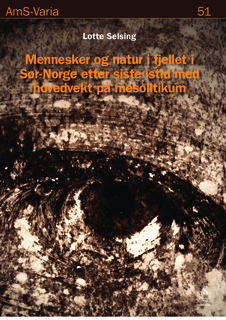| dc.description.abstract | The main aim of the project is to interpret people’s relationship to nature with emphasis on the culture of huntergatherers
in the mountain area of South Norway in the Mesolithic period. The palaeoenvironment and traces of
human interaction with nature in Dyraheio are used as a basis for a South Norwegian perspective. Further, the
relation between nature and settlement in the mountain area is analysed from a South Norwegian perspective.
The cultural characteristics of hunter-gatherers are used to analyse the relation between people, settlement and
nature, to propose a cultural meaning of reindeer for Mesolithic hunter-gatherers and a division of territories in
South Norway.
Dyraheio is located in the mountain area of Setesdal Vesthei in Southwest Norway in the low alpine vegetation
zone. The climate is dominated by the Atlantic cyclones in the west, with more continental conditions in the
east. This mountain area has harsh climatic conditions with 7-8 months of snow cover. The methods used in the
study are palynology, radiocarbon dated pine mega fossils, stratigraphy and radiocarbon dates. The palynological
analysis on samples of gyttja, peat and podsolic soil at the Late Mesolithic sites showed changes in the occurrence
of charcoal particles. The variation in especially Onagraceae (probably fireweed, Epilobium angustifolium),
ferns (Polypodiaceae), heather (Calluna, Empetrum and Ericales in general) and clubmosses (Lycopodium) is interpreted
as being due to human action. Some of the variations of the palynomorphs may have resulted from
gathering activities for food, for cleaning and use for resting places, for fuel and from vegetation management.
The results indicate that people stayed more often and possibly for longer periods in these areas than recorded by
archaeological observations alone.
The environmental changes in the mountain areas of South Norway since deglaciation are synthesised. They
occurred earlier in western areas than in eastern areas and earlier in higher areas than in lower areas. The forest
limit was at its uppermost and most stable limit during the Early Holocene. Pine dominated the subalpine forest
many places, especially in the east, and was mixed to varying degrees with birch. The “Holocene thermal optimum”
started around 8000 BP (8900 cal BP). The dominance of pine started to decline around 6700 BP (7580 cal
BP) and at the same time the first traces of a decline in the forest limit are recorded. Birch gradually became the
dominant tree and the subalpine birch forest was established during the period 5700-4400 BP (6480-4970 cal BP)
with a declining forest limit and deterioration of the climate. From about 4400 BP (4970 cal BP) grazing domestic
animals influenced the composition of the vegetation. The grazing hampered the re-growth of trees as the animals
were eating the young plants. Grazing husbandry also caused wearing and erosion of the soil. The “Holocene
thermal optimum” ended in the period 4000-3500 BP (4470-3770 cal BP) and the subalpine birch forest was more
open. The drop in the forest limit was considerable from 3700-3300 BP (4040-3520 cal BP) and low alpine vegetation
spread over still larger areas at the same time as pasturing husbandry increasingly changed the vegetation
into a cultural landscape similar to the one known in historical times and up to the present.
Radiocarbon dates are used as a record of the Stone Age settlement in the mountain area. The dates show a continuous
presence of people, and the only hiatus in the dataset is found during the Late Preboreal chronozone. This
homogeneity indicates that hunter-gatherers regularly used the mountain area in an annual cycle. Presumably
the range of the variations in nature was accepted and presupposed in the hunter-gatherer culture and generally
satisfied the people’s living requirements.
Nearly all the radiocarbon dated archaeological sites in the mountain area were located below the forest limit
at the time of use. The subalpine forest was a better base than the alpine landscape to safeguard the regular economic
resources of the society. This location provided easy access to resources in the alpine and subalpine areas,
with more divergent biotopes than the alpine area alone. The subalpine forest probably also had richer and more
varied resources than the alpine area and was the only vegetation zone where the three largest ungulates (reindeer,
elk and deer) could be expected. When the forest limit dropped, the biotopes where settlement sites had
been located were poorer and societal safety weakened. [...] | no_NO |
